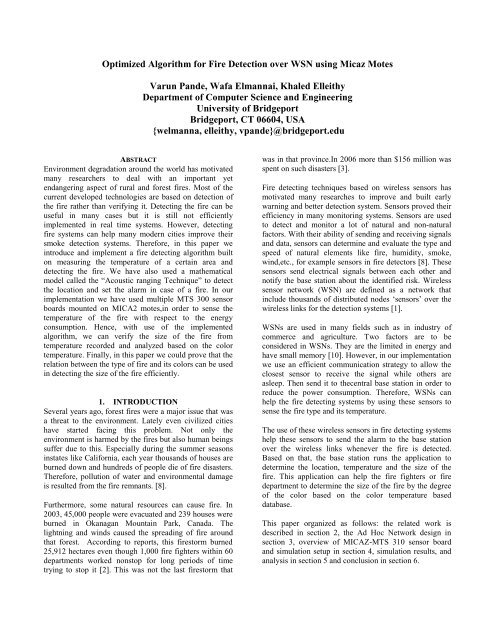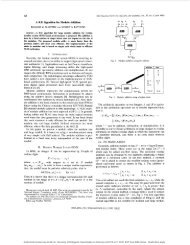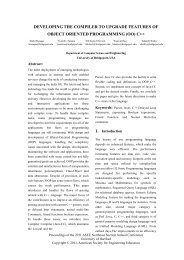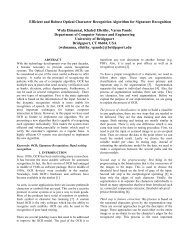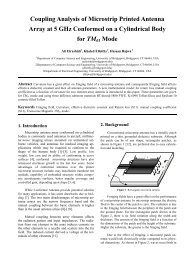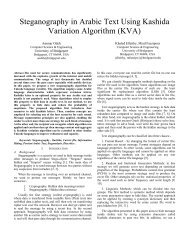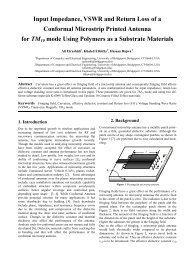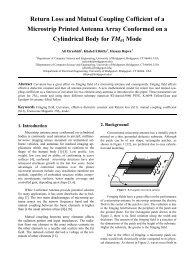Optimized Algorithm for Fire Detection over WSN ... - ResearchGate
Optimized Algorithm for Fire Detection over WSN ... - ResearchGate
Optimized Algorithm for Fire Detection over WSN ... - ResearchGate
Create successful ePaper yourself
Turn your PDF publications into a flip-book with our unique Google optimized e-Paper software.
<strong>Optimized</strong> <strong>Algorithm</strong> <strong>for</strong> <strong>Fire</strong> <strong>Detection</strong> <strong>over</strong> <strong>WSN</strong> using Micaz Motes<br />
Varun Pande, Wafa Elmannai, Khaled Elleithy<br />
Department of Computer Science and Engineering<br />
University of Bridgeport<br />
Bridgeport, CT 06604, USA<br />
{welmanna, elleithy, vpande}@bridgeport.edu<br />
ABSTRACT<br />
Environment degradation around the world has motivated<br />
many researchers to deal with an important yet<br />
endangering aspect of rural and <strong>for</strong>est fires. Most of the<br />
current developed technologies are based on detection of<br />
the fire rather than verifying it. Detecting the fire can be<br />
useful in many cases but it is still not efficiently<br />
implemented in real time systems. However, detecting<br />
fire systems can help many modern cities improve their<br />
smoke detection systems. There<strong>for</strong>e, in this paper we<br />
introduce and implement a fire detecting algorithm built<br />
on measuring the temperature of a certain area and<br />
detecting the fire. We have also used a mathematical<br />
model called the “Acoustic ranging Technique” to detect<br />
the location and set the alarm in case of a fire. In our<br />
implementation we have used multiple MTS 300 sensor<br />
boards mounted on MICA2 motes,in order to sense the<br />
temperature of the fire with respect to the energy<br />
consumption. Hence, with use of the implemented<br />
algorithm, we can verify the size of the fire from<br />
temperature recorded and analyzed based on the color<br />
temperature. Finally, in this paper we could prove that the<br />
relation between the type of fire and its colors can be used<br />
in detecting the size of the fire efficiently.<br />
1. INTRODUCTION<br />
Several years ago, <strong>for</strong>est fires were a major issue that was<br />
a threat to the environment. Lately even civilized cities<br />
have started facing this problem. Not only the<br />
environment is harmed by the fires but also human beings<br />
suffer due to this. Especially during the summer seasons<br />
instates like Cali<strong>for</strong>nia, each year thousands of houses are<br />
burned down and hundreds of people die of fire disasters.<br />
There<strong>for</strong>e, pollution of water and environmental damage<br />
is resulted from the fire remnants. [8].<br />
Furthermore, some natural resources can cause fire. In<br />
2003, 45,000 people were evacuated and 239 houses were<br />
burned in Okanagan Mountain Park, Canada. The<br />
lightning and winds caused the spreading of fire around<br />
that <strong>for</strong>est. According to reports, this firestorm burned<br />
25,912 hectares even though 1,000 fire fighters within 60<br />
departments worked nonstop <strong>for</strong> long periods of time<br />
trying to stop it [2]. This was not the last firestorm that<br />
was in that province.In 2006 more than $156 million was<br />
spent on such disasters [3].<br />
<strong>Fire</strong> detecting techniques based on wireless sensors has<br />
motivated many researches to improve and built early<br />
warning and better detection system. Sensors proved their<br />
efficiency in many monitoring systems. Sensors are used<br />
to detect and monitor a lot of natural and non-natural<br />
factors. With their ability of sending and receiving signals<br />
and data, sensors can determine and evaluate the type and<br />
speed of natural elements like fire, humidity, smoke,<br />
wind,etc., <strong>for</strong> example sensors in fire detectors [8]. These<br />
sensors send electrical signals between each other and<br />
notify the base station about the identified risk. Wireless<br />
sensor network (<strong>WSN</strong>) are defined as a network that<br />
include thousands of distributed nodes ‘sensors’ <strong>over</strong> the<br />
wireless links <strong>for</strong> the detection systems [1].<br />
<strong>WSN</strong>s are used in many fields such as in industry of<br />
commerce and agriculture. Two factors are to be<br />
considered in <strong>WSN</strong>s. They are the limited in energy and<br />
have small memory [10]. However, in our implementation<br />
we use an efficient communication strategy to allow the<br />
closest sensor to receive the signal while others are<br />
asleep. Then send it to thecentral base station in order to<br />
reduce the power consumption. There<strong>for</strong>e, <strong>WSN</strong>s can<br />
help the fire detecting systems by using these sensors to<br />
sense the fire type and its temperature.<br />
The use of these wireless sensors in fire detecting systems<br />
help these sensors to send the alarm to the base station<br />
<strong>over</strong> the wireless links whenever the fire is detected.<br />
Based on that, the base station runs the application to<br />
determine the location, temperature and the size of the<br />
fire. This application can help the fire fighters or fire<br />
department to determine the size of the fire by the degree<br />
of the color based on the color temperature based<br />
database.<br />
This paper organized as follows: the related work is<br />
described in section 2, the Ad Hoc Network design in<br />
section 3, <strong>over</strong>view of MICAZ-MTS 310 sensor board<br />
and simulation setup in section 4, simulation results, and<br />
analysis in section 5 and conclusion in section 6.
2. RELATED WORK<br />
There are limited fire detection systems that have been<br />
implemented and presented in literature. Most of these<br />
systems are only theoretical models rather than<br />
implementation. There is other multiple systems that are<br />
based on a single technique or on mixed techniques (e.g.<br />
mixed of multisensory and wireless cameras).However, in<br />
this section we have studied several proposed works<br />
which are related to our work.<br />
The Forest <strong>Fire</strong> Surveillance system (FFSS) was<br />
improved by Son et. al.in order to <strong>over</strong>view South Korea<br />
Mountain [12]. This paper combined a web application,<br />
transceiver, <strong>WSN</strong> and middleware. The nodes used<br />
TinyOS as their operating system. The nodes collect the<br />
dimensions of the environment requirements such as<br />
humidity and temperature. The received node (Sink-node)<br />
sends these measurements to the software. Then the risk is<br />
determined by the middle ware software. Finally, the<br />
alarm is activated by FFSS <strong>for</strong> early warning of the fire.<br />
In [5], the fire behavior is detected by <strong>Fire</strong> Wx Net. Fir<br />
Wx Net targets to measure the condition of the current<br />
weather and detect the visual data <strong>for</strong> both the base station<br />
as well as around the <strong>for</strong>est. These zone images are taken<br />
continuously. Hence, the natural factors such as<br />
temperature and wind speed should be measured by the<br />
system from time to time to determine the improvement<br />
of the risk. Also, the beauty of the system was that the<br />
team could prove that their system could be a realistic<br />
system <strong>for</strong> fire behavior analysis.<br />
A new algorithm was introduced by Li et. al. in order to<br />
implement fire detection system <strong>for</strong> boreal zone in<br />
Canada [9]. The authors did not use only the satellite<br />
remote sensor in their system, but also they used the<br />
Advanced Very High Resolution Radiometer (AVHRR)<br />
to provide a high quality images around the fire. The<br />
system showed good features such as quick response and<br />
high quality of images <strong>for</strong> long distances.<br />
Different from the systems presented earlier in this<br />
section, in [7] Wireless Local Area Network (WLAN)<br />
was used to determine the fire. The design in [7] is based<br />
on the verification of the fire rather than detect it. The<br />
improvement of this work is using the cameras and multisensor<br />
nodes. Hence, this system follows several steps to<br />
detect and verify the fire. Whenever a multi-sensor node<br />
detects the fire, the server receives the warning alarm <strong>over</strong><br />
the network. The end user invokes the proposed<br />
application on the server to determine the closest camera<br />
easily. Lastly, the taken images are sent to the sink nodes.<br />
This system is used in real time.<br />
A reliable framework is proposed in [4] <strong>for</strong> general<br />
reportage <strong>over</strong> the <strong>WSN</strong>s. The experiment shows that this<br />
general frame work can be used <strong>for</strong> fire detection. The<br />
developing team’s focus is on the importance of<br />
circulation of detection systems. In order to reroute the<br />
data to the sink rapidly, the team introduces a new<br />
algorithm <strong>for</strong> collecting the data. The system filters the<br />
delayed - aware data as well as the significant data.<br />
The presented techniques in this section have different<br />
features but lack the ability to specify the relation of the<br />
fire type and its temperature to its colors. In our new<br />
implementation presented in this paper, we show and<br />
elaborate how these factors can determine the size of the<br />
fire. Further, we are using MICA2 motes to sense the<br />
temperature of the fire and define its location using<br />
acoustic ranging.<br />
3. PROPOSED WORK<br />
3.1. Over view and experimental setup:<br />
In this section we demonstrate the setup of our approach<br />
and the hardware features that support our deployment.<br />
Also, in this section we discuss several devices used in<br />
the proposed architecture. In our experimental tests, we<br />
use MTS300 sensor board. This board includes important<br />
modules such assounder, thermometer, a Dual-Axis<br />
accelerometer (ADXL202), photon cell and Dual-Axis<br />
magnetometer [6]. However, the main components we use<br />
are the microphone, the sounder, the photon cell and<br />
thermometer to measure the temperature. Each<br />
component has a unique feature <strong>for</strong> our experimental tests<br />
and is explained in the following sub-sections.<br />
A. Microphone circuit<br />
Acoustic ranging and a general acoustic recording<br />
measurement are the two main functions in this circuit.<br />
This circuit includes both a pre- amplifier (U1A-1) and<br />
second-stage amplifier with a digital-pot control (U1A-<br />
PT2). In acoustic recording and measurement principle<br />
the output of the low level of microphone is increased by<br />
preamplifier. With the help of an output selector (MX),<br />
the analog digital converter (ADC) can serve the output of<br />
microphone’s low level. That can be done when the<br />
output selector links both ADC2 and mic_out signal. The<br />
storage devices of motes store the audio files. In second<br />
output, after the Tone Detector received the mic_out<br />
signal from filter (U), the analog microphone signal will<br />
be turned to the low or high level. The converted stage<br />
occurs usually when the tone becomes 4 kHz. This Tone<br />
will be generated on the board later by the sounder [11].<br />
B. The Sounder<br />
The sounder is a simple frequency with a range of 4KHZ.<br />
It includes both frequency and drive control circuitry. The
power switch is the only device that can control this<br />
sounder’s operation.<br />
C. The Light and Temperature Sensors<br />
A/D converter channel (ADC) is the shared channel <strong>for</strong><br />
the light and the temperature sensors as shown in Figure<br />
1. It has a circuitry which allows only one sensor to work<br />
at a time [11]. The Cdse Photo is the light sensor. There<br />
are two conditions <strong>for</strong> this sensor that is a dark and a light<br />
condition. The digital control signal has to be on to use<br />
this sensor. ADC is always connected to the light sensor<br />
output in order to know the condition of the sensor.<br />
simulation and placement of the nodes, some nodes are<br />
specific <strong>for</strong> sending the RF packet to the master nodes by<br />
the activation of thelight sensor.<br />
Send RF<br />
Packet<br />
Activate<br />
Sounder<br />
Yes<br />
Data On<br />
Temperature<br />
Readings<br />
If Threshold<br />
Broken<br />
No<br />
Temperature<br />
Readings<br />
If Night<br />
Yes<br />
Initialize Light<br />
Sensors<br />
No<br />
Start<br />
Initialize Master<br />
Node<br />
Communicate<br />
With Base<br />
Station<br />
Initialize tone<br />
detector on<br />
Send Data To<br />
Basestation<br />
Data On<br />
Spectral<br />
Readings<br />
Spectral<br />
Readings<br />
Analyze Data<br />
Display<br />
Output<br />
Figure 2: MTS300 <strong>Fire</strong> <strong>Detection</strong> system flow chart<br />
Stop<br />
Figure1:The power controlled signal of MTS300 <strong>for</strong> Temperature and<br />
Light sensors.<br />
Other nodes are specific toactivate the sounder whenever<br />
fire is detectedor the temperature threshold is broken.<br />
The main focus of our application is to apply the acoustic<br />
ranging principle <strong>for</strong> tone detector and sounder sensor.<br />
Our experiment shows that both RF packet and radio<br />
signal are sent at the same time. By setting a counter on<br />
the timer on mote’s process, it can receive RF packet and<br />
start to listen <strong>for</strong> the tone at the same time. Also, the<br />
beauty of this application is that, we can detect the fire<br />
location easily. This is done by increasing the counter<br />
until the microphone on the base station detects the tone<br />
produced by the sensor that detected the fire. This way we<br />
can calculate the time of flight of the sound and thus<br />
comparatively localize the location of the fire even<br />
though the wireless nodes are distributed randomly.<br />
3mts<br />
Acoustic Signal<br />
Acoustic Signal<br />
3Mts<br />
Master Node<br />
Base Station<br />
Acoustic Signal<br />
Acoustic Signal<br />
Figure 3: The System Architecture<br />
3mts<br />
3mts<br />
3.2. The Work Process and System Architecture<br />
In this section we explain the procedure and the flow of<br />
our experiment as shown as in Figure 2.<br />
Be<strong>for</strong>e initializing the master node, all the nodes are<br />
randomly distributed <strong>over</strong> the simulation area including<br />
the master node as shown in Figure 3. Figure 3 shows the<br />
architecture of the system and how the communication is<br />
done between the nodes and the master node as well as<br />
between the master node and the base station. Since the<br />
distribution is random, there is no known location of the<br />
nodes. However, an experimental area can include close<br />
to 1000 nodes and 200 master nodes. During the<br />
Each node has its own module <strong>for</strong> sensing,(each MTS 300<br />
panels committed to 2 separate MICAZ panels). Each<br />
sensor components has a separate sensor boards (each of<br />
the MTS 300 boards accomplish a separate task), and a<br />
light sensor is used by one board to detect the fire while<br />
the other measures the temperature and sets up the<br />
sounder (the fire is detected by the cdse photo cell).<br />
Whenever, any light sensor of the node detects the fire,<br />
then its parallel sensor has to activate the sounder by<br />
sending an acoustic signal if the threshold of the<br />
temperature is broken. The detected node will send the RF<br />
packet to the master node.
According to the acoustic ranging principle, the counter<br />
of master node has to be reset as soon as the node receives<br />
the RF packet. To allocate the fire place we have to<br />
calculate the time of flight of the sound signal by the<br />
sounder. It is calculated based on the time that took of the<br />
master node’s microphone to receive the sound signal.<br />
This approach is one of the easiest and non-expensive<br />
ways to allocate the fire without having a prior knowledge<br />
of the location of the node or acknowledgement from the<br />
detected node about the fire’s location.<br />
3.3 Methodology<br />
In our experimental tests we use MICA2 motes. The<br />
model we use is MPR400CB and the data radio is<br />
CC1000900mhz. Hence, the MTS300 CA is used in order<br />
to extent the sound, temperature and light sensors. The<br />
proposed frame work involves programming the motes<br />
<strong>for</strong> permitting them to communicate with the master node<br />
and allow the master node to communicate with base<br />
station. The sensors send the readable data to the base<br />
station. The data describes the increase in the temperature<br />
of the fire as shown in our implementation in Figure 4.<br />
Based on our study we found that there is a relation<br />
between the fire’s temperature and their colors. It is<br />
shown below whenever the temperature increases the<br />
color changes in several gradients. That can help us in<br />
detecting the size of the fire based on its colors.<br />
1. Red: as the temperature increases, the redness changes<br />
until it reach the cherry color be<strong>for</strong>e it changes to next<br />
case.<br />
a. Observable: 980 °F (525 °C).<br />
b. Bright: 1,300 °F (700 °C).<br />
c. Cherry, bright: 1,500 °F (800 °C).<br />
d. Cherry, full: 1,700 °F (900 °C).<br />
e. Cherry, pure: 1,800 °F (1,000 °C).<br />
2. Orange:<br />
a. Deep: 2,000 °F (1,100 °C).<br />
b. Pure: 2,200 °F (1,200 °C).<br />
3. White<br />
a. Whitish: 2,400 °F (1,300 °C).<br />
b. Cheerful: 2,600 °F (1,400 °C).<br />
c. Impressive: 2,700 °F (1,500 °C).<br />
In section 4 we discuss the results of our implementation<br />
and how with higher temperature and lower resistance of<br />
CKT we can get correct data.<br />
Figure 4:measured data of temperature of the fire is giving by several<br />
detected sensors<br />
4. ANALYSIS THE RESULTS<br />
As shown in section 3, we have used the MTS300CA<br />
sensor. MTS300CA helps in monitoring the energy of the<br />
fire and detects it as it moves around. The more fire<br />
spread around, the more nodes become active to detect the<br />
fire.<br />
A. The relation between the measured temperature and<br />
the accuracy data scenario:<br />
The complete <strong>Fire</strong> <strong>Detection</strong> system is implemented in<br />
NES C in UNIX Tiny OS plat<strong>for</strong>m or its equivalent<br />
Cygwin on a windows plat<strong>for</strong>m. A standard MEMSIC<br />
sensor board the MTS 300 mounted on top of the MICAZ<br />
was used <strong>for</strong> communication. An MIB 510 Program board<br />
isused to program the individual motes. The experimental<br />
results are conducted on a Pentium 2.4GHz computer<br />
system.<br />
Figure 5 shows the relation between the resistances in the<br />
board to the temperature. By examining Figure 5, we can<br />
conclude that the temperature increases as the resistance<br />
decreases which lead to the accuracy of the measurements<br />
in temperature. The Cdse Photon sensors of the MTS 300<br />
boards works as the primary detector in the initial<br />
detection of fire because factors like extreme sunlight or<br />
artificial light can confuse the photo sensor the thermistor<br />
of MTS300 takes care of the secondary measurement of<br />
temperature. Although the motes work perfectly<br />
individually, in order to c<strong>over</strong> a large area it is required to<br />
have multiple motes communicating with each other. As<br />
the distribution of motes is random we use the acoustic<br />
ranging technique which allows the motes to define its<br />
location to the base station.
Figure 5: Resistance VS Temperature Graph<br />
To evaluate the per<strong>for</strong>mance of our proposed <strong>Fire</strong><br />
<strong>Detection</strong> system, a number of scenarios were created<br />
using up to 4 pairs of motes (8 modules) to conduct our<br />
experiment. We measure the intensity of light that allows<br />
the data base to confirm the type of fire especially the size<br />
based on the temperature inputs. The detection rate is the<br />
ratio of successful attempts (cases where the best<br />
detection is the correct detection) to the total attempts.<br />
The results show that the detection rate is 92 %( increase<br />
in number of motes might provide betterresults). This<br />
makes our technique very suitable <strong>for</strong> many fire detection<br />
applications.<br />
B. Power Consumption Scenario:<br />
Figure 6 shows the behavior of power consumption of the<br />
sensors. Since the biggest issue in the wireless sensor<br />
networks is the energy consumption especially when there<br />
is random distribution of the sensors, it will be difficult to<br />
detect the sensor location to recharge in case the nodes<br />
run out of power. However, our results show that we can<br />
save in energy consumption of the sensor with our new<br />
algorithm. Since the experimental testsare based on<br />
activating several sensors which in and around the fire<br />
while the sensors areasleep,only the closest node will be<br />
active to detect the fire and in<strong>for</strong>m the base station. When<br />
the detected node in<strong>for</strong>ms the base station, base station<br />
will send a signal back to all the nodes in the base stations<br />
vicinity <strong>for</strong> accepting all the readable data.<br />
We also use the thermistor to measure the temperature.<br />
The measured temperature is retransmitted to the base<br />
station. With the use of the radio channel of the MTS300<br />
we can send warning alarm to other nodes. Finally in<br />
Figure 6 it is clear to see more temperature data was<br />
recorded when more power was consumed.<br />
Figure 6: the behavior of the power consumption Vs the temperature<br />
5. CONCLUSION<br />
<strong>Fire</strong> detection has been usedin many applications such as<br />
Forest fire Prevention systems, surveillance of volatile<br />
labs, etc. In this paper, we have proposed a new technique<br />
that implements a new fire detection algorithm. We have<br />
used MTS300CA that shows a high ability of monitoring<br />
in the MANET areas. The approach is fast, easy, and it<br />
provides a practical solution to the detection problem <strong>for</strong><br />
either accuracy of data or power consumption. The<br />
system has a success rate of 92% <strong>for</strong> a large set of<br />
scenarios. Our implementation could prove high result not<br />
only in detecting the fire but also in verifying the fire<br />
location specifically.<br />
This work is extended in the by using the IMB400<br />
multimedia boards and using filtering mechanisms and<br />
computer vision technology to improve the accuracy of<br />
detection as well as the exact location of the fire.<br />
REFRENCES<br />
[1] Ahmad Abed Alhameed Alkhatib and Gurvinder<br />
Singh Baicher, “An Overview of Wireless Sensor<br />
Networks”, 2012 International Conference on Computer<br />
Networks and Communication Systems (CNCS 2012),<br />
2012.<br />
[2] B.C. Ministry of Forests and Range.<strong>Fire</strong> Review<br />
Summary <strong>for</strong> Okanagan Mountain <strong>Fire</strong> (K50628).<br />
[3] B.C. Ministry of Forests and Range Web Page,<br />
http://www.<strong>for</strong>.gov.bc.ca .<br />
[4] E. Ngai, Y. Zhou, M. Lyu, J. Liu, “A Delay-aware<br />
Reliable Event Reporting Framework <strong>for</strong> Wireless<br />
Sensor-actuator Networks, Ad Hoc Networks,” Vol. 8,<br />
Issue 7, pp. 694-707, 2010Sdf.<br />
[5] Hartung, C.; Han, R.; Seielstad, C.; Holbrook, S. “<strong>Fire</strong><br />
WxNet: a multi-tiered portable wireless system <strong>for</strong><br />
monitoring weather conditions in wild land fire<br />
environments,” In ACM, 4th International Conference on<br />
Mobile Systems, Applications and Services, Uppsala,<br />
Sweden, June 19-22, 2006.
[6]http://bullseye.xbow.com:81/Products/productdetails.a<br />
spx?sid=177.<br />
[7] J. Lloret, M. Garcia, D. Bri, S. Sendra, A Wireless<br />
Sensor Network Deployment <strong>for</strong> Rural and Forest <strong>Fire</strong><br />
detection and verification, sensor Nodes, Vol. 9 , Issue<br />
<strong>Detection</strong> and Verification, Sensor Nodes, Vol. 9, Issue<br />
11, pp. 8722-8747, 2009.<br />
[8] Jaime Lloret, Miguel Garcia, Diana Bri and Sandra<br />
Sendra, “A Wireless Sensor Network Deployment <strong>for</strong><br />
Rural and Forest <strong>Fire</strong> <strong>Detection</strong> and Verification”, sensors<br />
,2009.<br />
[9] Li, Z.; Nadon, S.; Cihlar, J. Satellite-based detection<br />
of Canadian boreal <strong>for</strong>est fires: development and<br />
application of the algorithm. Int. J. Remote Sens. 2000,<br />
21, 3057–3069.<br />
[10] Mohamed Hefeeda and MajidBagheri, “Wireless<br />
Sensor Networks <strong>for</strong> Early <strong>Detection</strong> of Forest <strong>Fire</strong>s<br />
”, Mobile Adhoc and Sensor Systems, 2007.MASS<br />
2007.IEEE Internatonal Conference on, 2007.<br />
[11] MTS/MDA Sensor Board User’sManual, June 2006,<br />
PN: 7430-0020-04.<br />
[12] Son, B.; Her, Y.; Kim, J. “A design and<br />
implementation of <strong>for</strong>est-fires surveillance system based<br />
on wireless sensor networks <strong>for</strong> South Korea Mountains,”<br />
IJCSNS 2006, 6, 124-130.


